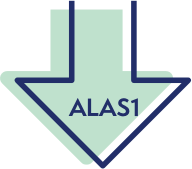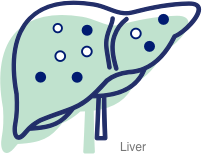What is GIVLAARI® (givosiran)?
GIVLAARI is a medicine used to treat acute hepatic porphyria (AHP) in adults. GIVLAARI can be used to treat all 4 types of AHP: acute intermittent porphyria (AIP), variegate porphyria (VP), hereditary coproporphyria (HCP), and ALAD-deficiency porphyria (ADP).
ALAD=delta-aminolevulinic acid dehydratase.
How GIVLAARI works
In people with AHP, the heme production process in the liver does not work properly because of a genetic mutation. In the liver, this process is controlled by an enzyme called delta-aminolevulinic acid synthase 1 (ALAS1).
When ALAS1 is activated, the heme production process is unable to keep up. This causes toxic substances called delta-aminolevulinic acid (ALA) and porphobilinogen (PBG) to build up. ALA and PBG are associated with attacks and other AHP symptoms.
GIVLAARI reduces the amount of ALAS1 in the liver, which leads to a reduction in levels of the toxins ALA and PBG.
Watch a video that illustrates how GIVLAARI works:
In the liver, GIVLAARI reduces the level of ALAS1.


This leads to a reduction in levels of toxins ALA and PBG.

ALA
PBG

ALA and PBG are associated with attacks and other AHP symptoms.
How GIVLAARI is given
GIVLAARI is given once a month as a subcutaneous injection (under the skin) by a healthcare professional. If a dose is missed, they should administer GIVLAARI as soon as possible. Your doctor may adjust your dose if you experience side effects.
